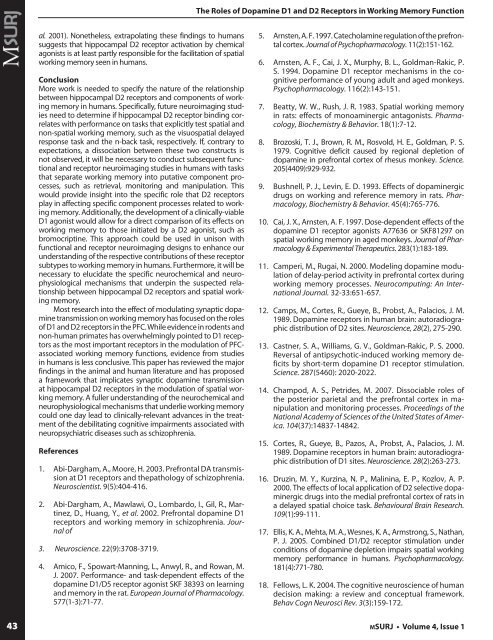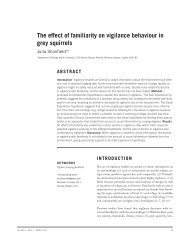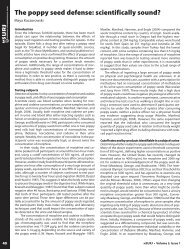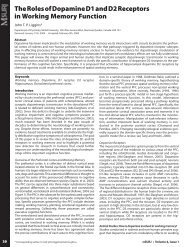the entire issue - McGill Science Undergraduate Research Journal ...
the entire issue - McGill Science Undergraduate Research Journal ...
the entire issue - McGill Science Undergraduate Research Journal ...
You also want an ePaper? Increase the reach of your titles
YUMPU automatically turns print PDFs into web optimized ePapers that Google loves.
The Roles of Dopamine D1 and D2 Receptors in Working Memory Function<br />
al. 2001). None<strong>the</strong>less, extrapolating <strong>the</strong>se findings to humans<br />
suggests that hippocampal D2 receptor activation by chemical<br />
agonists is at least partly responsible for <strong>the</strong> facilitation of spatial<br />
working memory seen in humans.<br />
Conclusion<br />
More work is needed to specify <strong>the</strong> nature of <strong>the</strong> relationship<br />
between hippocampal D2 receptors and components of working<br />
memory in humans. Specifically, future neuroimaging studies<br />
need to determine if hippocampal D2 receptor binding correlates<br />
with performance on tasks that explicitly test spatial and<br />
non-spatial working memory, such as <strong>the</strong> visuospatial delayed<br />
response task and <strong>the</strong> n-back task, respectively. If, contrary to<br />
expectations, a dissociation between <strong>the</strong>se two constructs is<br />
not observed, it will be necessary to conduct subsequent functional<br />
and receptor neuroimaging studies in humans with tasks<br />
that separate working memory into putative component processes,<br />
such as retrieval, monitoring and manipulation. This<br />
would provide insight into <strong>the</strong> specific role that D2 receptors<br />
play in affecting specific component processes related to working<br />
memory. Additionally, <strong>the</strong> development of a clinically-viable<br />
D1 agonist would allow for a direct comparison of its effects on<br />
working memory to those initiated by a D2 agonist, such as<br />
bromocriptine. This approach could be used in unison with<br />
functional and receptor neuroimaging designs to enhance our<br />
understanding of <strong>the</strong> respective contributions of <strong>the</strong>se receptor<br />
subtypes to working memory in humans. Fur<strong>the</strong>rmore, it will be<br />
necessary to elucidate <strong>the</strong> specific neurochemical and neurophysiological<br />
mechanisms that underpin <strong>the</strong> suspected relationship<br />
between hippocampal D2 receptors and spatial working<br />
memory.<br />
Most research into <strong>the</strong> effect of modulating synaptic dopamine<br />
transmission on working memory has focused on <strong>the</strong> roles<br />
of D1 and D2 receptors in <strong>the</strong> PFC. While evidence in rodents and<br />
non-human primates has overwhelmingly pointed to D1 receptors<br />
as <strong>the</strong> most important receptors in <strong>the</strong> modulation of PFCassociated<br />
working memory functions, evidence from studies<br />
in humans is less conclusive. This paper has reviewed <strong>the</strong> major<br />
findings in <strong>the</strong> animal and human literature and has proposed<br />
a framework that implicates synaptic dopamine transmission<br />
at hippocampal D2 receptors in <strong>the</strong> modulation of spatial working<br />
memory. A fuller understanding of <strong>the</strong> neurochemical and<br />
neurophysiological mechanisms that underlie working memory<br />
could one day lead to clinically-relevant advances in <strong>the</strong> treatment<br />
of <strong>the</strong> debilitating cognitive impairments associated with<br />
neuropsychiatric diseases such as schizophrenia.<br />
References<br />
1.<br />
2.<br />
Abi-Dargham, A., Moore, H. 2003. Prefrontal DA transmission<br />
at D1 receptors and <strong>the</strong>pathology of schizophrenia.<br />
Neuroscientist. 9(5):404-416.<br />
Abi-Dargham, A., Mawlawi, O., Lombardo, I., Gil, R., Martinez,<br />
D., Huang, Y., et al. 2002. Prefrontal dopamine D1<br />
receptors and working memory in schizophrenia. <strong>Journal</strong><br />
of<br />
3. Neuroscience. 22(9):3708-3719.<br />
4.<br />
Amico, F., Spowart-Manning, L., Anwyl, R., and Rowan, M.<br />
J. 2007. Performance- and task-dependent effects of <strong>the</strong><br />
dopamine D1/D5 receptor agonist SKF 38393 on learning<br />
and memory in <strong>the</strong> rat. European <strong>Journal</strong> of Pharmacology.<br />
577(1-3):71-77.<br />
5.<br />
6.<br />
7.<br />
8.<br />
9.<br />
Arnsten, A. F. 1997. Catecholamine regulation of <strong>the</strong> prefrontal<br />
cortex. <strong>Journal</strong> of Psychopharmacology. 11(2):151-162.<br />
Arnsten, A. F., Cai, J. X., Murphy, B. L., Goldman-Rakic, P.<br />
S. 1994. Dopamine D1 receptor mechanisms in <strong>the</strong> cognitive<br />
performance of young adult and aged monkeys.<br />
Psychopharmacology. 116(2):143-151.<br />
Beatty, W. W., Rush, J. R. 1983. Spatial working memory<br />
in rats: effects of monoaminergic antagonists. Pharmacology,<br />
Biochemistry & Behavior. 18(1):7-12.<br />
Brozoski, T. J., Brown, R. M., Rosvold, H. E., Goldman, P. S.<br />
1979. Cognitive deficit caused by regional depletion of<br />
dopamine in prefrontal cortex of rhesus monkey. <strong>Science</strong>.<br />
205(4409):929-932.<br />
Bushnell, P. J., Levin, E. D. 1993. Effects of dopaminergic<br />
drugs on working and reference memory in rats. Pharmacology,<br />
Biochemistry & Behavior. 45(4):765-776.<br />
10. Cai, J. X., Arnsten, A. F. 1997. Dose-dependent effects of <strong>the</strong><br />
dopamine D1 receptor agonists A77636 or SKF81297 on<br />
spatial working memory in aged monkeys. <strong>Journal</strong> of Pharmacology<br />
& Experimental Therapeutics. 283(1):183-189.<br />
11. Camperi, M., Rugai, N. 2000. Modeling dopamine modulation<br />
of delay-period activity in prefrontal cortex during<br />
working memory processes. Neurocomputing: An International<br />
<strong>Journal</strong>. 32-33:651-657.<br />
12. Camps, M., Cortes, R., Gueye, B., Probst, A., Palacios, J. M.<br />
1989. Dopamine receptors in human brain: autoradiographic<br />
distribution of D2 sites. Neuroscience, 28(2), 275-290.<br />
13. Castner, S. A., Williams, G. V., Goldman-Rakic, P. S. 2000.<br />
Reversal of antipsychotic-induced working memory deficits<br />
by short-term dopamine D1 receptor stimulation.<br />
<strong>Science</strong>. 287(5460): 2020-2022.<br />
14. Champod, A. S., Petrides, M. 2007. Dissociable roles of<br />
<strong>the</strong> posterior parietal and <strong>the</strong> prefrontal cortex in manipulation<br />
and monitoring processes. Proceedings of <strong>the</strong><br />
National Academy of <strong>Science</strong>s of <strong>the</strong> United States of America.<br />
104(37):14837-14842.<br />
15. Cortes, R., Gueye, B., Pazos, A., Probst, A., Palacios, J. M.<br />
1989. Dopamine receptors in human brain: autoradiographic<br />
distribution of D1 sites. Neuroscience. 28(2):263-273.<br />
16. Druzin, M. Y., Kurzina, N. P., Malinina, E. P., Kozlov, A. P.<br />
2000. The effects of local application of D2 selective dopaminergic<br />
drugs into <strong>the</strong> medial prefrontal cortex of rats in<br />
a delayed spatial choice task. Behavioural Brain <strong>Research</strong>.<br />
109(1):99-111.<br />
17. Ellis, K. A., Mehta, M. A., Wesnes, K. A., Armstrong, S., Nathan,<br />
P. J. 2005. Combined D1/D2 receptor stimulation under<br />
conditions of dopamine depletion impairs spatial working<br />
memory performance in humans. Psychopharmacology.<br />
181(4):771-780.<br />
18. Fellows, L. K. 2004. The cognitive neuroscience of human<br />
decision making: a review and conceptual framework.<br />
Behav Cogn Neurosci Rev. 3(3):159-172.<br />
43 MSURJ • Volume 4, Issue 1









